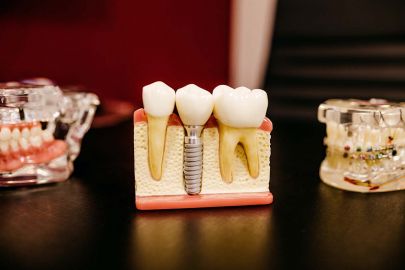Dental whitening also known as bleaching or tooth whitening is an excellent way to lighten the appearance of your teeth. If you want whiter teeth but don’t want to spend money on expensive cosmetic veneers, implants, and other bleaching processes then dental whitening might be for you. Dental brightening can lighten your teeth by several shades in just a few days and is inexpensive. Here we’ll explain tooth whitening, how it works, its costs and potential side effects.
What is Dental Whitening?
Dental whitening is a process that lightens your teeth. It involves application of special gels and/or strips that can remove stains from teeth. While this is an effective way to make teeth appear two to six shades lighter, it only works on natural tooth enamel, and won’t affect dental fillings or crowns. Dental whitening is used to lighten the color of a person’s teeth. It is done in a dental office by a dentist or a dental hygienist. You will receive special treatment to lighten your teeth. It can take one or two treatments to lighten teeth by one shade. It can take more than two treatments to whiten teeth by two or more shades.
How Does Dental Whitening Work?
Dental whitening is a process in which teeth are treated with a bleaching agent that results in a noticeable change of colour. The most common agents used for teeth whitening are hydrogen peroxide and carbamide peroxide. The bleaching agent is kept in contact with the teeth for a period of time, after which it is wiped off. The process of bleaching teeth is achieved by applying a strong peroxide-based gel or solution to the teeth. After a certain amount of time, the gel is removed and the teeth are rinsed out. Bleaching agents in the gel react with the organic matter present in the teeth, such as dried blood and food particles, as well as stains resulting from smoking or drinking coffee and other beverages, to produce hydrogen peroxide as a by-product.
What are the Different Types of Dental Bleaching?
Gels – Gels are the most widely used form of oral bleaching. They are applied directly onto the teeth and are either professionally applied in the dentist’s office or at home using a tray and mouth guards that hold the gel in place. Strips – Strips are thin pieces of perforated plastic that are applied directly onto the teeth and then slowly release the bleaching agent. They are less effective than gels, as they do not stay in contact with the teeth for as long.
Side Effects of Dental Bleaching
Dental whitening is generally safe and effective with minimal risks. However, some people experience discomfort and irritation when using a whitening gel or strips. Some of the possible side effects include swelling and sensitivity of the gums, tooth discoloration, and tooth erosion. Dental whitening can also remove the protective layer of enamel from your teeth, which could lead to sensitivity. If you have sensitive teeth and want to whiten them, your dentist may suggest using a desensitizing agent during the procedure.
Conclusion
Dental whitening has proven to be a very efficient and safe way of lightening up your smile. However, to maintain a beautiful smile, you have to follow your Southaven dentist’s instructions and avoid smoking and drinking coffee and other beverages that stain your teeth.




